Waka Flocka Flame, "Rooster In My Rari"
I think I might know who robbed that guy in a chicken suit from yesterday.
The Thirty Year Smoking Plan
“It’s interesting to keep in mind, if you smoke cigarettes, the lung cancer risk doesn’t go up for 30 years. And that’s a really powerful carcinogen. A lot of things don’t show up for several decades.”
— Some doctor, in an article which is actually about how artificial sweeteners will kill you with the cancer, but I don’t care about that right now. My takeaway is: thirty years! I can smoke for another four years and get away scot-free! Time to go celebrate with a cigarette. It’s not going to hurt me any!
Is "Prometheus" a Big Gorgeous Bag of Hot Foolish Space Garbage?

I’ve been quietly going back and forth on Prometheus — I love it! I hate it! — but this rather brutal evisceration of its plot is fairly convincing. Even though I’m okay with some things being “unknown” or “not entirely making sense…” some things are Not Okay. I will say it all becomes more convincing when you see it in Imax on a monster screen. Because you’re like, wow, so gorgeous! What a cast! So stunning! So loud! Except, you could probably say that about Triumph of the Will. I bet that would be amazing in 3D too. (via.)
Brush Your Teeth Or Get Cancer And Die
“Failing to brush your teeth properly could increase the risk of dying prematurely from cancer, researchers claim. They found a link between high levels of dental plaque, or bacteria, and dying from cancer up to 13 years earlier than might otherwise be expected. Those with the most bacteria on the surface of their teeth and gums had an 80 per cent increased risk of premature death.”
Everything You Need to Know About Today in Under Two Minutes
Did you know tonight is the Museum Mile Festival? Do you need a regular morning primer for the day ahead? Subscribe to this in iTunes right here.
Assorted Presidential Pets, In Order
Assorted Presidential Pets, In Order
by Sarah Marshall
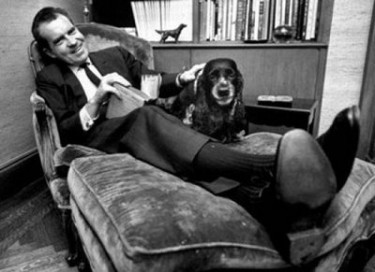
29. Misty Malarky Ying Yang, a Siamese cat belonging to the President’s daughter (Carter)
28. Washington Post, Yellow-Headed Mexican parrot (McKinley)
27. Maude, pig (Teddy Roosevelt)
26. Old Whitey, a horse the President had used during wartime and from whose tail White House visitors would pull hairs to keep as souvenirs (Zachary Taylor)
25. Old Whiskers, an ill-tempered goat who once escaped the White House lawn and had to be chased down Pennsylvania Avenue (Harrison)
24. Sweet Lips, Scentwell, Drunkard, Taster, Tipsy, Tipler, Lady Rover, Searcher, Mopsey, Captain, Vulcan, and Cloe, hounds (Washington)
23. Siam, the first Siamese cat in the United States (Hayes)
22. Emily, Lady Nashville, Bolivia, and Truxton, racehorses (Jackson)
21. Yuki, a mutt the President’s daughter had found at a Texas gas station (Lyndon Johnson)
20. Silkworms belonging to the First Lady (Quincy Adams)
19. A pair of tiger cubs given to the President by the Sultan of Oman, which he donated to the zoo at Congress’ suggestion (Martin Van Buren)
18. Fala, full name Murray the Outlaw of Falahill, a Scottish Terrier who survived the
President by seven years and was eventually buried alongside him (Franklin Delano
Roosevelt)
17. Nanny and Nanko, goats (Lincoln — who, to his credit, politely declined the King of Siam’s offer to send over unspecified number of elephants, because “it has occurred to us that, if on the continent of America there should be several pairs of young male and female elephants turned loose in forests… and all were forbidden to molest them; to attempt to raise them would be well and if the climate there should prove favourable to elephants, we are of opinion that after a while they will increase till there be large herds as there are on the Continent of Asia until the inhabitants of America will be able to catch them and tame and use them as beasts of burden making them benefit to the country.”)
16. Emily Spinach, garter snake (Teddy Roosevelt)
15. Sukey, cow (Harrison)
14. White mice the President found in his bedroom during the time of his impeachment, left flour and water for, and called the “little fellows” (Andrew Johnson)
13. A horse named the General, which the President later buried on his private estate under a gravestone reading: “Here lies the body of my good horse ‘The General.’ For twenty years he bore me around the circuit of my practice, and in all that time he never made a blunder. Would that his master could say the same! John Tyler.”
12. Sheep that grazed on the White House lawn (Wilson)
11. Tax Reduction and Budget Bureau, lion cubs (Coolidge)
10. Valeriano Weyler and Enrique DeLorne, Angora kittens (McKinley)
9. Mr. Reciprocity and Mr. Protection, opossums (Harrison)
8. Josiah, badger (Teddy Roosevelt)
7. Pauline Wayne, the last cow to live at the White House (Taft)
6. Butcher Boy and Jeff Davis, horses, and Billy Button and Reb, ponies (Grant)
5. Billy, pygmy hippo (Coolidge)
4. An alligator that lived in the White House bathroom and was given to the President by the Marquis de Lafayette (Quincy Adams)
3. Dr. Johnson, Bishop Doane, Fighting Bob Evans, Admiral Dewey, and Father O’Grady, guinea pigs (Teddy Roosevelt)
2. A Welsh terrier named Charlie, a mutt named Pushinka who was the daughter of the Soviet space dog Strelka and was gifted to the White House by Krushschev, and their puppies — Butterfly, White Tips, Blackie, and Streaker — which the President called “the pupniks” (Kennedy)
1. Checkers, Cocker Spaniel (Nixon)
Related: Roman Emperors, Up To AD 476 And Not Including Usurpers, In Order Of How Hardcore Their Deaths Were
Sarah Marshall is the proud owner of an imaginary Corgi named Ruggles.
Flag-Waving Chicken Victim Of Robbery Most... Ugh, Okay, Fine, Robbery Most Fowl
“I have a feeling this is going to be a once-in-a-lifetime experience and I’m going to be looking back on this in thirty years laughing still,” says a man dressed in a chicken suit who had an American flag stolen from him as he celebrated the reopening of a Boston Market restaurant. The level of pathos here is just impossible to deal with.
"Copper" on BBC America
by Luke Hopping
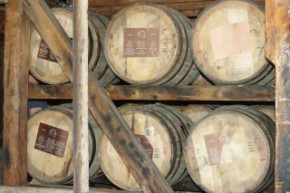
Content series are produced in partnership with our sponsors. This edition of “19th Century Libations” is brought to you by “Copper” on BBC America.
BBC America’s Copper is a police drama set during the Civil War in New York City — where the beat patrolled ranges from the Five Points up to luxurious Fifth Avenue and all the way into rural northern Manhattan. As any student knows, 19th century New York was one hard-drinking, hard living place to be. Since the premiere of “Copper” is fast approaching, here is everything you’d want to know about America’s sordid relationship with alcohol during that blurry-eyed era.
Popular portrayals of liquor in the 19th century conjure images of whiskey bottles labeled with X’s and inebriated shootouts, but they overlook the more pervasive drinking problems that plagued America’s cities — and the working poor and immigrants who lived there. Daniel Okrent, author of Last Call: The Rise and Fall of Prohibition, noted that 19th century drinking patterns were roughly triple our own. That figure becomes all the more startling when you take into account the drunken renaissance our country is currently undergoing (a recent Gallup Poll found the drinking rate is the highest it has been since the mid-1980s, when drinking ages across the nation were inflated to keep intoxicated teens off the road). Without excluding children, the elderly, or any other group adverse to imbibing, the average American still consumed a gag-inducing 3.9 gallons of alcohol annually in 1830.
One can only imagine what a drinker in their prime must have been putting down. Furthermore, almost no segment of society was excluded from the merriment; during the Civil War, certain branches of the military were provided alcohol rations, for curative, as well as morale-boosting, purposes. Picture a world in which, odds on, everyone you met in a given day was at least a little tipsy, and, at the end of four years, you didn’t have to graduate and get a job. You do die of liver failure at 58, though.
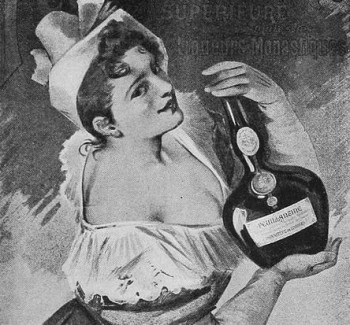
But while the drinks may have been stronger and the parties crazier, so was the opposition. In 1854, when New York Governor Horatio Seymour vetoed a bill that would have prohibited the sale of liquor, he was promptly replaced at the ballot by dry candidate Myron H. Clark. Within months of Clark’s inauguration, the sale of liquor was outlawed in the Empire State. All told, twelve states enacted prohibitory alcohol laws in the lead-up to the Civil War. (The actual extent to which these bans were enforced, however, is unclear.) Still, alcohol consumption fluctuated violently. From its peak in 1830, drinking fell to an all-time low in popularity just fifteen years later. Much like individuals who drink excessively today, America seems to have spent most of the century in a cycle of binge and regret. While teetotalers would have to wait until 1919 for their brief moment in the sun, it was evident they were on the march at least a century earlier.
Yet, in spite of the protestations of a zealous minority, drinking remained shockingly inescapable at the onset of “Mr. Lincoln’s War,” as it was pejoratively called, particularly in inner cities. We’re betting the incredible focus on booze seeps into “Copper” depiction of crime in New York’s slums, when it arrives on August 19th. It’s hard to imagine how it won’t.
This content was created for our sponsor Copper on BBC America.
How To Make Beer Ice Cream
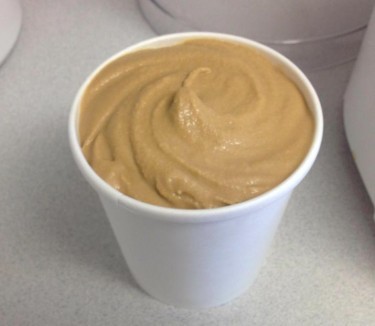
A series on things to make, eat and imbibe this summer.
My current pipe dream is to drive an ice-cream food truck and stock it with nontraditional flavors — tamarind sorbet, dark chocolate-beet ice cream, honey mustard custard. So far I can see only two obstacles: not having start-up capital and not having a driver’s license. But even if it were to happen, I still wouldn’t be able to sell my favorite recipe as there are probably crazy restrictions on selling alcohol-soaked ice cream out of a brightly colored van.
The recipe here is adapted from a four-ingredient beaut from the LA Times that happens to be the second result you get when you Google “beer ice cream.” There are only two steps. I KNOW. The recipe was super-easy to begin with, and I’ve since found a few easy tweaks that make it essentially foolproof. You can trust me on this, I am a fool and I have proofed this. If there were any additional ways to make this ice cream wrong, I would have uncovered them. But this recipe is simple to make, and the four-ingredient part is wonderful, too. It’s also a good one to double.
Ingredients:
4 egg yolks
½ cup sugar [see notes below]
1 cup beer (8 ounces, so you’re fine with a single bottle or can)
1 cup heavy cream
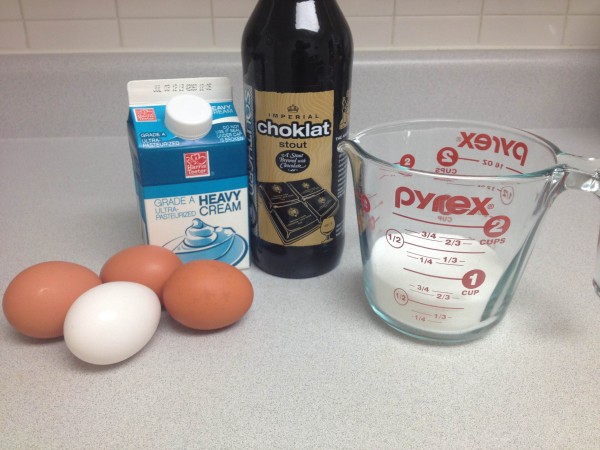
Special Equipment:
ice-cream maker, bowl that can get really hot without melting, helper (optional)
Yield: a pint and a half
1. Mix the egg yolks and the sugar together in a bowl that can stand a lot of heat. I prefer to do this by hand, although not necessarily by my hand. If there’s someone else around, hand the bowl over and ask them to whisk the bejeezus out of the yolks and sugar. The promise of beer ice cream is usually enough to convince someone to do this for you. Which frees your arms up for…
2. Heat the beer and heavy cream to a simmer in a pot over the stove, stirring occasionally. If you leave the room and it foams over the side of the pot a bit, don’t despair! That happens to me more often than I should admit and it always works out okay (I told you this was foolproof). While it simmers, drink the rest of the beer.
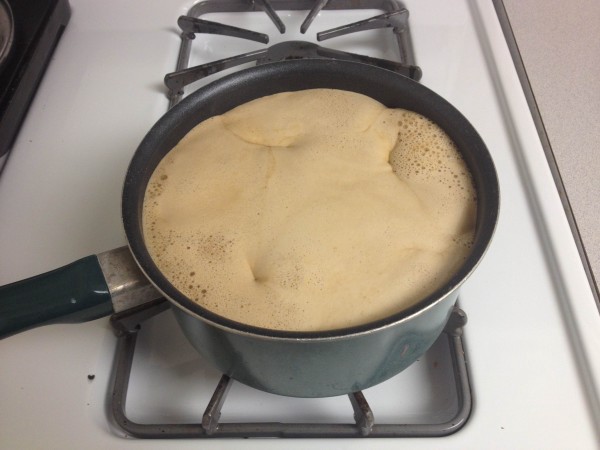
3. Pour the hot beer cream into the sugar yolks. Do this slowly, and if your friend is around have them whisk while you pour (watch out for splashing). If you’re doing this solo, you’ll have to go easy: pour a little bit of hot beer cream into the eggs, whisk swiftly, pour a little more into the bowl, whisk again, and so on until everything’s in the mixing bowl. If the egg yolks heat up too quickly, you will have milky sweet scrambled eggs. Try to avoid that.
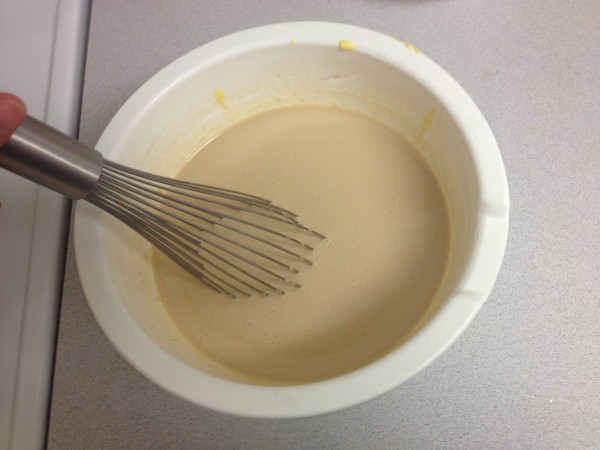
4. Pour the mixture back into the pot and heat over low until it’s thickened, stirring occasionally. As instructions go, “thickened” is really vague; the first few times I made ice cream I had no idea how to tell if it was thick enough and warmed it for like half an hour. I like recipes to be overly specific, so: between five and seven minutes. It should “coat the spoon.” It won’t be like pudding, which is what I expected the first time around. Just… a little bit thicker.
5. Pour the whole thing back into the mixing bowl and leave it in the fridge, ideally overnight but for at least five hours. The LA Times recipe suggests that you pour it through a strainer, but this has never made a noticeable difference to me. Pour it through a strainer if you feel like it.
6. After the cooling period, churn! Churn like the wind! As it says on every ice cream recipe, churn according to the instructions on your ice cream maker.
7. Post-churn, the ice cream will have the consistency of soft serve. IT IS NOT DONE YET even though it tastes amazing. Transfer your ice cream to a container and put it in the freezer for a minimum of three hours. Tupperware is fine, though frequent freezing may cause the plastic to crack. I bought a sleeve of disposable pint containers, which is a little wasteful but if you’re bringing the ice cream somewhere, it looks neat and you don’t have to worry about getting the container back.
8. That’s it! Enjoy your delicious homemade beer ice cream!
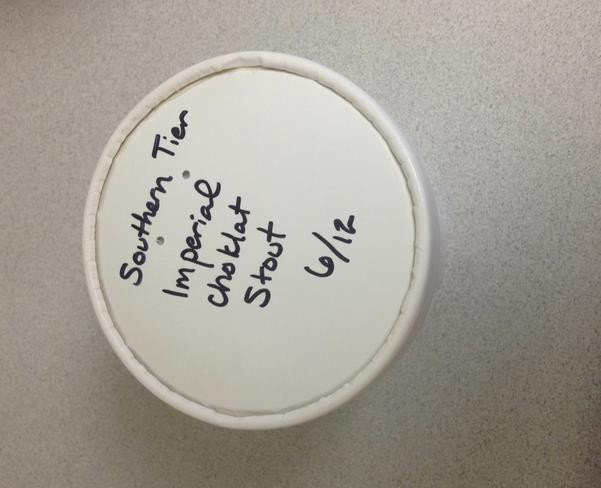
Miscellaneous notes:
• If you’re using a bitter or excessively hoppy beer, consider increasing the sugar by up to ¼ cup if you want more of a classic ice-cream taste. If you want it to just taste like the beer, disregard this advice but do not decrease the sugar! There’s some science-y purpose it serves, I dunno.
• This recipe is the one I use most often when making ice cream. It’s extremely versatile just because of the staggering amount of beers you can use. Sweet, rich beers make for the most decadent ice cream: try a fruit lambic or Trappist ale.. The beer in the photos, Southern Tier’s Imperial Choklat Stout produced a delightful twist on a standard chocolate ice cream. But it was chosen only because Southern Tier’s Creme Brulee Stout wasn’t yet available — that one is released annually in June. I hoard bottles of this stuff for ice-cream purposes, it’s that good.
• Because the yield here is approximately a pint and a half, I often double the recipe so it produces an even three pints. Should you do this, the only amendment to the recipe (aside from the amounts, naturally) is to chill it in two bowls. Churning it all at once may overload the machine. As for the machine itself? I use a Cuisinart that was on sale for like $35. These things are always on sale somewhere.
Previously: Grilled Shrimp and Asparagus
Victoria Johnson eats dessert first.
The New Rap Is the Old Rap Just Better
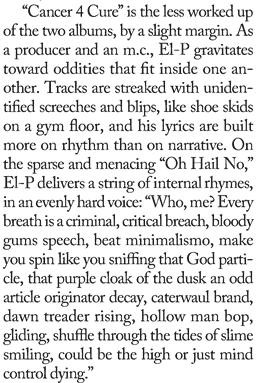
Today in the New Yorker (subscription-only!), Sasha Frere-Jones looks at El-P and Killer Mike, “survivors of a kind of roisterous political hip-hop that seemed to have faded away.” But has not! And is more “roisterous” than ever! (As we have noticed and enjoyed more than quite a bit.) Here’s our recent guide to the New York City rap scene.
